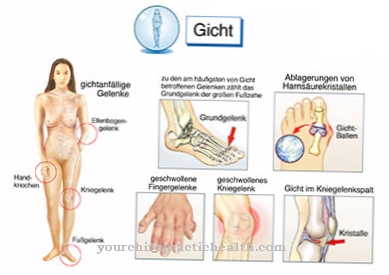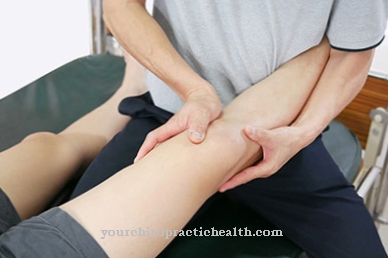The arterial occlusive disease (AVK) or peripheral arterial occlusive disease (PAD) is, like the smoker's leg, colloquially as Intermittent claudication designated. This leads to a sometimes life-threatening arterial circulatory disorder of the extremities (feet, legs, arms, hands). The main cause of this disease is hardening of the arteries due to an unhealthy lifestyle. Smoking, little exercise and a lot of fatty and cholesterol-rich food are particularly responsible for arterial occlusive disease.
What is arterial occlusive disease?

The arterial occlusive disease is colloquially known as "intermittent claudication". The reason for this is that it forces the patient to stop and pause after just a short walk. The gait is thus similar to that of the strollers strolling from shop window to shop window and stopping briefly to look at the goods on display.
In addition, the arterial occlusive disease is responsible for the so-called smoker's leg. In principle, the smoker's leg is an arterial occlusive disease that was triggered or caused by the patient's long-term smoking.
Older people over the age of 65 are particularly prone to developing this disease. Men in particular have a higher risk of developing smokers' legs or arterial occlusive disease.
causes
The arterial occlusive disease is caused by a circulatory disorder in the extremities. This circulatory disorder is caused by a narrowing or even an occlusion of the main artery or those arteries that supply the extremities.
In the case of arterial occlusive disease, narrowing or occlusion occurs due to hardening of the arteries. This disease, also known as arteriosclerosis, is the cause of around ninety-five percent of patients with arterial occlusive disease. Inflammatory vascular diseases are further, albeit significantly less common, causes of arterial occlusive disease.
Since the vascular calcification in this disease is a creeping and slowly progressing process, the effects are worsened enormously, especially when the risk factors interact.
You can find your medication here
➔ Medicines for smoking cessationSymptoms, ailments & signs
Arterial occlusive disease shows different symptoms, which depend on the affected parts of the body and the stage of the disease. If the extremities are affected, the symptoms correspond to those of peripheral arterial occlusive disease. In the early stages the condition does not cause any symptoms.
As the arterial occlusion progresses, it finally comes to stress pain. These occur where the arterial occlusion is pronounced. This can be in the legs, for example, or it can be seen in the form of angina pectoris. In the beginning, these stress pain only occur after or during physical activity.
Pain at rest occurs as the disease progresses. Finally, the last symptoms are inflammation, ulcers and necrosis on parts of the body with poor circulation. With the loss of tissue, especially in the extremities, there is also a loss of sensory abilities. Amputations may be necessary in severe cases.
However, it is not only the extremities that are affected by the narrowed vessels. Narrowed blood vessels can lead to a variety of symptoms in the body. For example, it can lead to circulatory disorders in the brain and resulting thromboses carry an increased risk of strokes, heart attacks and embolisms. In addition, constricted vessels contribute to general weakness, as nutrients and oxygen are not optimally transported.
course
The arterial occlusive disease predominantly affects the lower extremities or their arteries. Depending on the stage of the disease, the symptoms of those affected range from a subjective symptomlessness to stress pain when walking and a consequent restriction of walking distance to stress-independent pain and ulcers called gangrene, which make amputation necessary.
The arterial occlusive disease therefore initially sets in unnoticed, as the artery occlusion occurs gradually - just as high blood pressure does not hurt an arterial occlusion in the initial stage. In women, it takes an average of ten years longer for arterial occlusive disease to be diagnosed. It is all the more important to know the main risk factors for arterial occlusive disease.
In addition to smoking and diabetes mellitus, these are high blood pressure and lipid metabolism disorders. The last three factors occur particularly in the case of obesity. In this respect, the first and best measure to prevent arterial occlusive disease is to reduce obesity and to stop smoking immediately.
An example: In men and women who smoke, the onset of the disease averages fifty-five years. Sixty-five years of age in non-smoking women. And even if men have a three times higher risk of developing arterial occlusive disease, this advantage is negated by women who smoke. They also belong to the main risk group.
Unfortunately, the first signs of arterial disease are often neither noticed nor taken seriously. Most people only see their doctor if their calf hurts more often when walking. But even for those who go to the doctor, the start of treatment for arterial occlusive disease can often be delayed due to misdiagnosis.
Finally, pain in the calf can also indicate an orthopedic problem, such as a torn muscle fiber. The dangerous thing about it: The arterial occlusive disease not only affects the legs, but also the arteries that supply the heart and brain are narrowed. This means you are at high risk of a heart attack or stroke.
Complications
Complications that develop from arterial occlusive disease are always based on an insufficient supply of certain areas of the body with oxygen-rich arterial blood. Accordingly, the resulting complications can vary widely. They range from barely noticeable to immediately life-threatening situations.
For example, coronary artery disease, which is also classified as arterial occlusive disease, can develop into angina pectoris associated with chest pain or, if one of the main coronary arteries is completely blocked, even an immediately life-threatening myocardial infarction. If one or both renal arteries are affected by arterial occlusive disease and have severe stenoses of more than 75 percent, what is known as renal hypertension initially occurs.
The kidneys increasingly secrete the vasoconstricting hormone renin, which, via the mechanism of vasoconstriction, leads to increased blood pressure and can cause complications associated with high blood pressure. The insufficient supply of the kidneys with arterial blood can severely hinder the functioning of the kidneys and the most extreme complication can be a kidney infarction analogous to a heart attack.
The best known arterial occlusive disease is probably peripheral arterial occlusive disease (PAD), which affects the lower extremities.The disease, which affects heavily smokers above average, is also known as intermittent claudication because those affected like to stand in front of shop windows because of severe pain in their legs after walking in order to conceal their illness.
Most of the complications discussed will resolve once blood flow is restored through the affected arteries. The prerequisite for this is that no irreversible limits have been exceeded.
When should you go to the doctor?
Arterial occlusive disease is a progressive disease that can lead to various sequelae. These include peripheral arterial occlusive disease and coronary heart disease. The symptoms caused by these (and other) ailments are usually serious for the person concerned.
If a person notices that it is more difficult to walk, raise their arms or stand, that the limbs feel stiff after low stress and that there is a general feeling of weakness, arterial occlusive disease may be the cause. Angina pectoris - pain in the chest area when exerted - is also a clear sign. Both conditions should be urgently evaluated by a doctor and treated if possible.
If an arterial occlusive disease is suspected, a doctor should always be consulted, as this disease can be greatly delayed in its development. People belonging to a risk group should be examined as a precaution. This includes smokers, overweight people and people with other underlying diseases. In addition, a high-fat diet promotes arterial constriction.
Patients who have already been diagnosed with arterial occlusive disease should definitely consult their doctor in the event of acute deterioration in their condition. Depending on the equipment and specialization, a general practitioner can be consulted for the initial diagnosis. Further - possibly also invasive - measures require a visit to a vascular specialist.
Doctors & therapists in your area
Treatment & Therapy
The therapy or treatment of arterial occlusive disease by a vascular specialist aims to prevent precisely this. Treatment is based on the immediate elimination of risk factors. This includes giving up nicotine, lowering cholesterol, and controlling high blood pressure and diabetes.
Consistent gait training as part of what is known as vascular exercise leads to an improvement in blood circulation in the legs, because the movement of the muscle creates new small blood vessels around the constriction or expands the existing ones. The pain can also be relieved through increased activity. Gentle would be the wrong way here. In addition, every form of exercise contributes to lowering blood lipid levels and blood pressure. Endurance sports are the best medicine for treating arterial disease.
Outlook & forecast
The prognosis for arterial occlusive disease primarily depends on whether the triggering factors can be eliminated. This is the only way to prevent the disease from progressing, because even a surgical procedure is no guarantee of permanent freedom from symptoms. The bottleneck can sometimes close again. Life expectancy is shorter for patients with arterial occlusive disease, because they usually suffer from other vascular diseases and the risk of heart attacks and strokes is significantly increased.
The prognosis is positively influenced by preventive measures in the form of a healthy lifestyle (e.g. achieving a normal body weight, avoiding cigarettes, diets low in fat and cholesterol, physical activity). If the arterial occlusive disease is based on an embolism and its source cannot be eliminated, long-term medication to inhibit blood clotting is necessary for a better prognosis.
If a thrombosis is the cause of the arterial occlusive disease, therapy with so-called platelet aggregation inhibitors is carried out, which can also have a positive effect on the prognosis. For a favorable prognosis, the cooperation of the patient is always necessary. If the lifestyle is not adjusted accordingly, the prognosis is rather poor.
Aftercare
Immediately after the operation, the patient must first stay in bed. Pulse, blood pressure and bandages are checked regularly so that complications can be identified as quickly as possible and countermeasures can be taken. Even during the operation, the patient receives heparin, which inhibits blood clotting.
This is to prevent blood clots from forming in the operated area or other pre-stressed parts of the body. Even after the operation, heparin is initially given regularly. In the period after the operation, blood values are also checked regularly in order to identify and treat inflammation or other discrepancies.
Later on after the operation, the patient must go to the doctor for check-ups. First the check takes place after four to six weeks, later every six months and finally only annually. In these tests, the doctor assesses whether the blood can continue to flow well. If this is not the case, the question of a new operation may arise.
In order to avoid future arterial occlusions, the patient can take preventive measures himself with a healthy lifestyle with an appropriately balanced diet, sufficient exercise and refrain from smoking. Medicines prescribed by a doctor should also be taken as directed.
You can find your medication here
➔ Medicines for smoking cessationYou can do that yourself
The mild stages of arterial occlusive disease can be delayed a little, or even greatly delayed in its development, if the person concerned changes his or her lifestyle.
Important risk factors should as far as possible be banned from life. These include smoking, consuming large amounts of fat and lack of exercise. Instead, the focus should be on a light diet rich in vitamins and minerals. Because the additional nutrients and the better metabolism support the body in building new vessels. This ensures an improvement in the peripheral blood circulation and prevents further ailments.
The insufficient oxygen supply to the tissue must also be compensated. Sports activities ensure better blood circulation and sustainably increase the lung volume, so that the blood becomes richer in oxygen and the tissue can be better supplied despite the narrowing of the arteries. Endurance sports such as swimming, running or cycling are particularly suitable here.
Even regular walks can help. In addition, attention should be paid to breathing. Conscious and deep breathing leads to a better supply of oxygen.
If you experience stress pain, it can help to stretch your legs (or arms), tap them gently, or rub them. However, the measures only alleviate the symptoms.



.jpg)




















.jpg)



